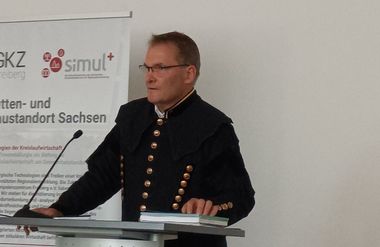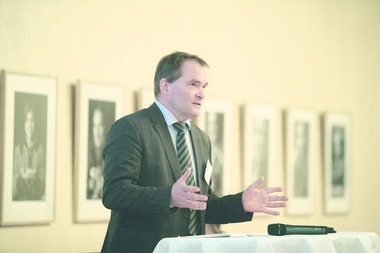„Europe: From Mine to Market“ –
International Conference on Raw Materials in Dresden
raw materials industry - a sector unimaginable without globalization - were on the agenda of last year’s Conference on Raw Materials held on September 28th and 29th, 2017 in Dresden. Other important topics discussed in this context were the technological trends and economic developments impacting the safeguarding of the raw material supply in Germany. The Minor Metals Trade Association, London (MMTA) in cooperation with the Geokompetenzzentrum Freiberg e.V., Freiberg/Saxony (GKZ) organized the event involving the EU Research Project FAME Flexible And Mobile Economic Process Technologies.
Dr.-Ing. Wolfgang Reimer, Managing Director of the GKZ, warmly welcomed the fifty participants and described the current raw material situation in comparison with historical data: “Agricola had all he needed for his work, from mining to extraction. Today, mining is a global business”. It was all the more pleasing - even in the light of Great Britain’s “Brexit” - that the cooperation between MMTA and GKZ worked so well and Maria Cox, Managing Director of the MMTA, could be welcomed. The conference in Dresden is one of the measures both institutions agreed upon to better link their members.
Introduction to the subject
On the occasion of the forum, Peter Robinson, British Fluorspar Ltd., Derbyshire/Great Britain, critically addressed the question: „Will there be an exit from the mining business (a “Prexit” - in accordance with his country’s exit from the EU)?“ He complained that politicians in the European Union did very little for the mining industry. The development of a sustainable mining industry, which needs to embrace global research results, is extremely important. Using fluorspar as an example, the speaker concluded that Europe would have to join forces in the mining sector. Europe consumes 700 000 t of this valuable mineral per year, while producing only 220 000 t, which results in a dependence on imports. Not only does this refer to extraction and marketing, but to research as well. He gave a detailed report on the history of fluorspar mining in the Peak District in Middle England, which started in 1938 – 13 years before the Peak District National Parc was established - and has recently turned into “truckless mining”, i.e. mining without heavy-duty transports, but with treatment and underground backfilling. Sustainable mining, as this example shows, enables the preservation of the habitat for people and animals despite the exploitation process, he concluded. The production of limestone in open-pit mining as well as renaturation and waste management including the processing of the tailings were other topics of his lecture.
Finally, he summarized the most important requirements for a successful, sustainable European mining industry, which comprise e.g. pragmatic policies enabling the development and mining of minerals within a reasonable time frame, or partnerships between sponsors of mining projects, local municipalities and the government, and the establishment of local communities weighting both advantages and mining issues.
The focus of the speech given by John Meyer, SP Angel Corporate Finance LLP, London, was on minor metals in mining and their marketing. “Their future has just begun! “, said the author, who started his lecture asking a lot of questions: Who will be the leading mining companies in future? Where will be the future markets? What are the technological trends? How does the customer behavior affect product development? Which political relevance will minor metals have? Based on known procedures, he showed ways to improve the mining business while taking into account politics, industry, research and development. He described the different mining conditions legally required and thus also the political framework within Europe as the most serious obstacles.
Situation prior to production - the upstream picture
In his speech “Indium - smart technologies for a smart production”, Dr. Marco Roscher, Saxore Bergbau GmbH, Freiberg, presented the so-called Tellerhäuser project for the extraction of indium in the Ore Mountains as the hidden treasure of Europe. In the associated tin deposit, which comprises the mining regions of Tellerhäuser, Hämmerlein, Pöhla, Antonsthal and Breitenbrunn, about 100 000 t of tin are deposited. Approx. 2000 t of indium are contained as minor metals. The ore body was examined in detail and described - showing that with approx. 240 000 t, the region holds considerable amounts of tin along with Sn and In. The company, in cooperation with other companies, such as the Loser Chemie GmbH Langenweißbach, evaluates the mineability of the deposit using different methods (analyses regarding the solubility of the ore). The speaker presented a possible treatment process for the Hämmerlein region and set up a mass balance. The overall potential is indicated with 7.56 mt, with 1.03 % of SN (77 900 t), 1.3 % of Zn (98 300 t) as well as 63 ppm of In, the life-span of the mine is estimated to be 21 years.
Under the heading “Europe’s contribution to the production of minor metals”, Dr. Chris Broadbrent, Director of the Wardell Amstrong International LLP, Baldhu, Great Britain presented the FAME Project, a European research project that stands for the development of flexible, quick and economic process technologies (see also AT Mineral Processing, issue 10/2016, p. 58 ff).
Under the spectacular title of “SOS metallurgy - save our smelters”, Prof. Dr.-Ing. Dr. hc. Markus Reuter, Director of the Heimholtz Institute Freiberg for Resource Technology, Freiberg/Saxony, explained his concept regarding the preservation of the European metallurgical know-how and the integration of metallurgy into a sustainable industry for primary and secondary raw materials. He enlarged, in particular, on the nature and the aims of the circular economy, but also on the strategies regarding sustainable recycling. In this context, he illustrated the recyclability of products as key for a reasonable circular economy (CCE - Circular Economy Engineering). The product type decides on the recycling route: simple melting and refining (I), dismantling (II) or shredding and sorting (III). Numerous examples as well as the limitations of the CEE were demonstrated.
Processing/ Exploitation/Marketing -
Downstream Integration
The speeches in the second lecture block dealt with an equally interesting topic - the marketing of the products. Donna Vareha-Welsh, Director of the Metals Business Unit of the Indium Corporation, Clinton, NY/USA gave a lecture on the “Supply and Demand in a Global Market”. Taking the approach of the Indium Corporation as an example, she explained the way a company must act to remain successful in the global market, taking into account the numerous changes that happen there almost every day. As opportunities to increase the sales potential of indium, the speaker mentioned the reduction of losses due to unsuitable refineries, the accumulation of the residues from refineries as well as losses in yield in the refining process and the neglected potential of EoL recycling (End-of-Life) of consumer goods. Besides pricing mechanisms and the role of China as a global player, she gave valuable information on procurement strategies and other tools providing enterprises with an optimum marketing background.
“When minor metals turn into main metals” – this was the topic of Charles Swindon, Managing Director of the metal trading company RJH Trading Ltd., London. He took tungsten, nickel, aluminum, platinum, cobalt and vanadium as well as tantalum and indium as examples to illustrate this for the 20th century. He, too, discussed the important role of China for the production and the trading of metals with a view to the year 2025, mentioning the control of the minor metal supplies due to oversupply in the home country and the price control by government export bans as examples. This alone, but also the worldwide climate change, urge for new technologies to be used for products requiring minor metals, such as wind turbines, solar panels or batteries. The old smelting and production procedures are outdated and need to be replaced by “greener” solutions. Recycling will strongly influence the future of minor metals.
With his interesting lecture on “Milestones of Metallurgy - Past, Present, Future”, Prof. Dr. Ernst Pernicka from the University of Heidelberg made a trip to the past and presented his vision of the future application of metallurgy.
Mining in the Ore Mountains
A special highlight of the event was the tour through the exhibition mine of Pöhla in the Eastern Ore Mountains. Here, in the 1950s/60s, large deposits of complex ores (skarn stones combined with uranium, bismuth, tin, tungsten, iron and silver) were discovered. Here, the SDAG Wismut operated uranium ore mines until 1989/90. In 1991, the newly founded Mismut GmbH started to flood the uranium deposit and carried out extensive restoration work. In particular, the tin chambers resulting from the tin ore mining - excavated as experimental mining in 1976/77 - are eloquent witnesses of ore mining in this region. However, it is planned to really use this deposit in future, as this skarn deposit is the largest tin deposit in Europe (see article by M. Roscher).
In December 2016, the construction work for the new Pöhla-Globenstein mine began; the expected start of the commercial mining is planned in 2019.
Closing remarks
In his closing remarks, Dr. Chris Broadbrent once more emphasized the importance of mining and processing as well as of the refining of raw ores for the development of Europe: “Mining and metal processing have been carried out for thousands of years, but for the 21st century, new and sustainable extraction and processing methods as well as marketing structures are required for companies to be successful in the global market.” Therefore, the FAME project is extremely important. Ways for the technical improvement and the increase in efficiency in the development and processing of complex low-grade ore deposits were shown, which account for a great deal of the European resources of tin, tungsten and important minor metals. Against this background, the conference has fulfilled its purpose, but thanks also go to the organizer and the speakers.












